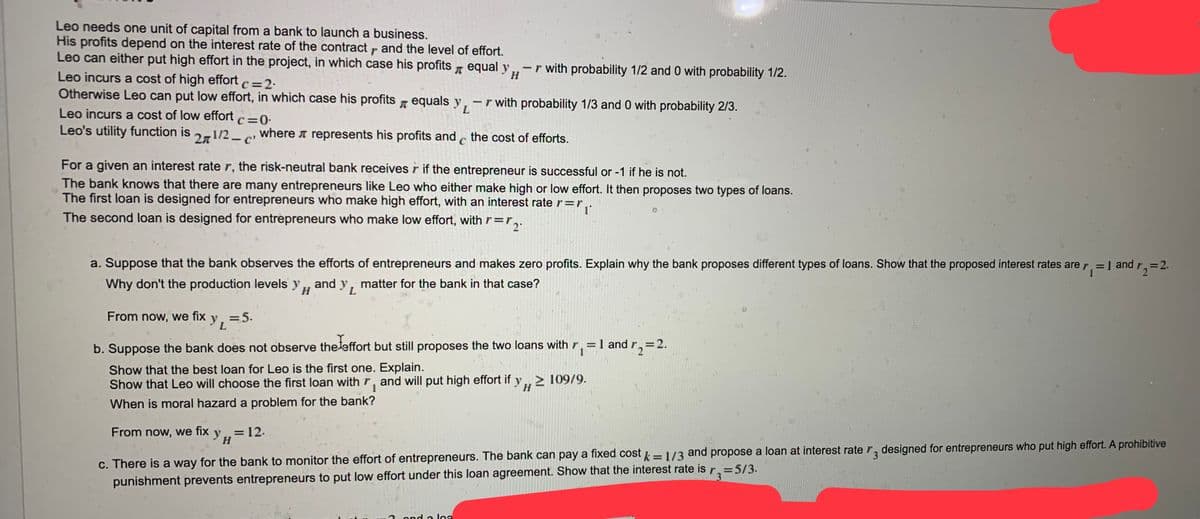a. Suppose that the bank observes the efforts of entrepreneurs and makes zero profits. Explain why the bank proposes different types of loans. Show that the proposed interest rates are r₁=1 and r₂ =2. Why don't the production levels y, and y, matter for the bank in that case? H From now, we fix =5. L b. Suppose the bank does not observe the leffort but still proposes the two loans with r, = 1 and r₂ = 2. Show that the best loan for Leo is the first one. Explain. Show that Leo will choose the first loan with r, and will put high effort if y,,2 109/9. When is moral hazard a problem for the bank? From now, we fix = 12. Ун c. There is a way for the bank to monitor the effort of entrepreneurs. The bank can pay a fixed cost k = 1/3 and propose a loan at interest rater, designed for entrepreneurs who put high effort. A prohibitive punishment prevents entrepreneurs to put low effort under this loan agreement. Show that the interest rate is r₂ = 5/3. 3 2 end o log
a. Suppose that the bank observes the efforts of entrepreneurs and makes zero profits. Explain why the bank proposes different types of loans. Show that the proposed interest rates are r₁=1 and r₂ =2. Why don't the production levels y, and y, matter for the bank in that case? H From now, we fix =5. L b. Suppose the bank does not observe the leffort but still proposes the two loans with r, = 1 and r₂ = 2. Show that the best loan for Leo is the first one. Explain. Show that Leo will choose the first loan with r, and will put high effort if y,,2 109/9. When is moral hazard a problem for the bank? From now, we fix = 12. Ун c. There is a way for the bank to monitor the effort of entrepreneurs. The bank can pay a fixed cost k = 1/3 and propose a loan at interest rater, designed for entrepreneurs who put high effort. A prohibitive punishment prevents entrepreneurs to put low effort under this loan agreement. Show that the interest rate is r₂ = 5/3. 3 2 end o log
Chapter7: Uncertainty
Section: Chapter Questions
Problem 7.5P
Related questions
Question

Transcribed Image Text:Leo needs one unit of capital from a bank to launch a business.
His profits depend on the interest rate of the contract r and the level of effort.
Leo can either put high effort in the project, in which case his profits 7 equal y
-r with probability 1/2 and 0 with probability 1/2.
H
|
Leo incurs a cost of high effort c=2-
Otherwise Leo can put low effort, in which case his profits 7 equals y,-r with probability 1/3 and 0 with probability 2/3.
Leo incurs a cost of low effort
L
c=0:
%3D
Leo's utility function is
271/2- c where A represents his profits and c the cost of efforts.
For a given an interest rate r, the risk-neutral bank receives r if the entrepreneur is successful or -1 if he is not.
The bank knows that there are many entrepreneurs like Leo who either make high or low effort. It then proposes two types of loans.
The first loan is designed for entrepreneurs who make high effort, with an interest rate r=r,.
The second loan is designed for entrepreneurs who make low effort, with r=r,
2
a. Suppose that the bank observes the efforts of entrepreneurs and makes zero profits. Explain why the bank proposes different types of loans. Show that the proposed interest rates are,
=1 and r=2.
Why don't the production levels y , and y, matter for the bank in that case?
L
From now, we fix
y
= 5.
%3D
L
b. Suppose the bank does not observe theleffort but still proposes the two loans with r.=1 and r,=2.
I and
%3D
Show that the best loan for Leo is the first one. Explain.
Show that Leo will choose the first loan with r, and will put high effort if y , > 109/9.
1
H
When is moral hazard a problem for the bank?
From now, we fix
y
= 12.
%3D
H
c. There is a way for the bank to monitor the effort of entrepreneurs. The bank can pay a fixed cost = 1/3 and propose a loan at interest rate r, designed for entrepreneurs who put high effort. A prohibitive
punishment prevents entrepreneurs to put low effort under this loan agreement. Show that the interest rate is r.=5/3.
%3D
ond a loa
Expert Solution
This question has been solved!
Explore an expertly crafted, step-by-step solution for a thorough understanding of key concepts.
Step by step
Solved in 3 steps

Knowledge Booster
Learn more about
Need a deep-dive on the concept behind this application? Look no further. Learn more about this topic, economics and related others by exploring similar questions and additional content below.Recommended textbooks for you


Managerial Economics: A Problem Solving Approach
Economics
ISBN:
9781337106665
Author:
Luke M. Froeb, Brian T. McCann, Michael R. Ward, Mike Shor
Publisher:
Cengage Learning


Managerial Economics: A Problem Solving Approach
Economics
ISBN:
9781337106665
Author:
Luke M. Froeb, Brian T. McCann, Michael R. Ward, Mike Shor
Publisher:
Cengage Learning